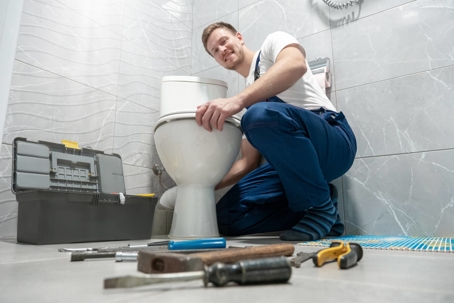We’re all familiar with the saying, “If it ain’t broke, don’t fix it.” Often, though, the real dilemma we face is whether something should be fixed or replaced. After all, why replace something if you can repair it? When it comes to toilets, sometimes a repair is all you need, but there are other times when replacing it will be the best financial choice in the long run.
Below, we’ll cover some common toilet issues and explain which ones (typically) make sense to repair and which ones (again, typically) make replacement the better option.
1. The toilet is having problems flushing.
If your toilet won’t flush or has trouble flushing completely, it needs a repair, and the job should be relatively straightforward. You might need to replace the handle or the flapper. In some cases, you only need to tighten the handle or adjust the length of the chain attached to the handle.
2. The toilet clogs regularly.
If your toilet clogs every couple of weeks (or even more often), there’s probably a clog somewhere in your toilet or in the drain. If plunging isn’t doing the trick, contact a plumber to cable the drain and remove the obstruction. Liquid-Plumr and Drano won’t be any help to you here and might cause more problems.
If your toilet is really old (40 years or older), and clogs occur regularly, it may be time to replace it. Over the decades, your toilet has likely accumulated mineral buildup inside that’s blocking waste and toilet paper.
3. The tank or bowl has a crack.
Typically, if there is only a hairline crack in the tank or bowl, a plumber can repair it for you with plumbing epoxy. However, most plumbing experts advise against repairing a crack that’s wider than 1/16 of an inch. At that point, even if the plumber tries to fix it, there’s a substantial risk of the repair not working. If the repair fails, you’ll have a considerable leak to contend with. Bottom line: If the crack is wider than 1/16 of an inch, you’ll want to get a replacement.
4. The toilet won’t stop running.
If your toilet doesn’t stop running after you’ve flushed, the chain on the flapper might’ve caught on something, and that’s what’s keeping the flapper open (and your toilet “running”). Try jiggling the handle or opening up the toilet tank and tugging the chain gently so that the flapper can close again. Once the flapper closes and water fills the tank, the problem will most likely be fixed.
If this doesn’t solve the issue, then you might need to adjust the chain length or replace the flapper. An entire toilet replacement is not necessary.
5. The whole toilet wobbles or tilts.
There are multiple reasons why a toilet might tilt or move. In some cases, your floor might be sagging, which you’ll want to look into right away. It’s also possible that your toilet’s wax seal needs to be replaced, or its bolts need to be tightened.
A broken flange can also cause a toilet to tilt. The flange is the metal or plastic ring that is supposed to fix the toilet to the floor. Unlike replacing other components, replacing a flange can be an expensive job. If you own an old and inefficient toilet, you may end up saving more money in the long run by investing in a new WaterSense labeled toilet, which requires significantly less water to flush.
Toilet Repairs and Replacements in Gilbert
At EZ Flow Plumbing, LLC, we have been providing homeowners and business owners in our community with exceptional plumbing services since 2007. Our motto is “painless plumbing.” Our Gilbert plumbing team is dedicated to providing you with quality toilet repairs and top-notch customer service.
Contact our Gilbert toilet repair team today for a painless plumbing experience: (480) 351-1820.

